Ultrastructural view of astrocyte arborization, astrocyte-astrocyte and astrocyte-synapse contacts, intracellular vesicle-like structures, and mitochondrial network
- PMID: 35283239
- PMCID: PMC9050955
- DOI: 10.1016/j.pneurobio.2022.102264
Ultrastructural view of astrocyte arborization, astrocyte-astrocyte and astrocyte-synapse contacts, intracellular vesicle-like structures, and mitochondrial network
Abstract
The complexity of astrocyte morphology and syncytial coupling through gap junctions are crucial for astrocyte function in the brain. However, the ultrastructural details of astrocyte arborization and interactions between neighboring astrocytes remain unknown. While a prevailing view is that synapses selectively contact peripheral astrocyte processes, the precise spatial-location selectivity of synapses abutting astrocytes is unresolved. Additionally, knowing the location and quantity of vesicles and mitochondria are prerequisites to answer two emerging questions - whether astrocytes have a signaling role within the brain and whether astrocytes are highly metabolically active. Here, we provided structural context for these questions by tracing and 3D reconstructing three neighboring astrocytes using serial block-face scanning electron microscopy. Our reconstructions reveal a spongiform astrocytic morphology resulting from the abundance of reflexive and leaflet processes. At the interfaces, varying sizes of astrocyte-astrocyte contacts were identified. Inside an astrocyte domain, synapses contact the entire astrocyte, and synapse-astrocyte contacts increase from soma to terminal leaflets. In contrast to densely packed vesicles at synaptic boutons, vesicle-like structures were scant within astrocytes. Lastly, astrocytes contain dense mitochondrial networks with a mitochondrial volume ratio similar to that of neurites. Together, these ultrastructural details should expand our understanding of functional astrocyte-astrocyte and astrocyte-neuron interactions.
Keywords: Aldh1l1-eGFP; Astrocyte network; Mitochondria; Serial blockface scanning electron microscopy (SBF-SEM); Synapses; Synaptic-like microvesicles; Three-dimensional reconstruction.
Copyright © 2022 Elsevier Ltd. All rights reserved.
Conflict of interest statement
Conflict of Interest Statement:
The authors declare no competing interests.
Figures
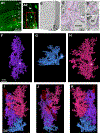
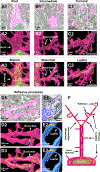

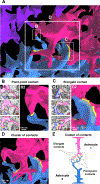

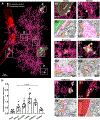

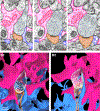
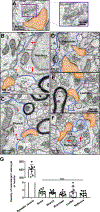

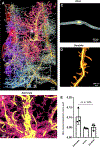
References
Publication types
MeSH terms
Grants and funding
LinkOut - more resources
Full Text Sources
Miscellaneous

